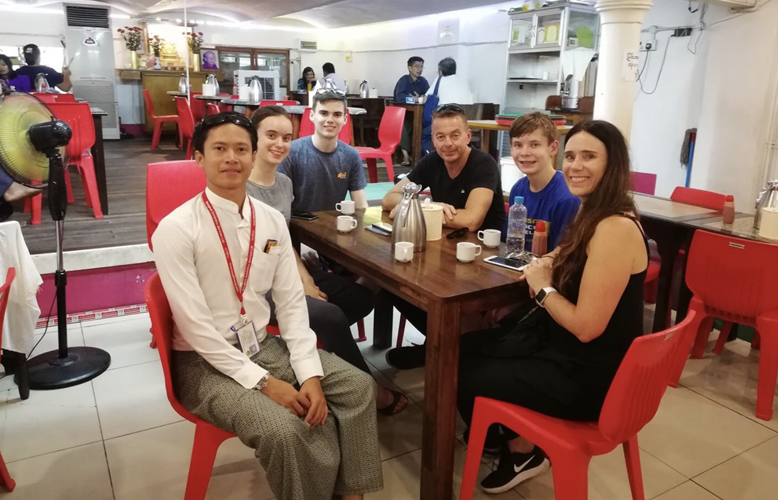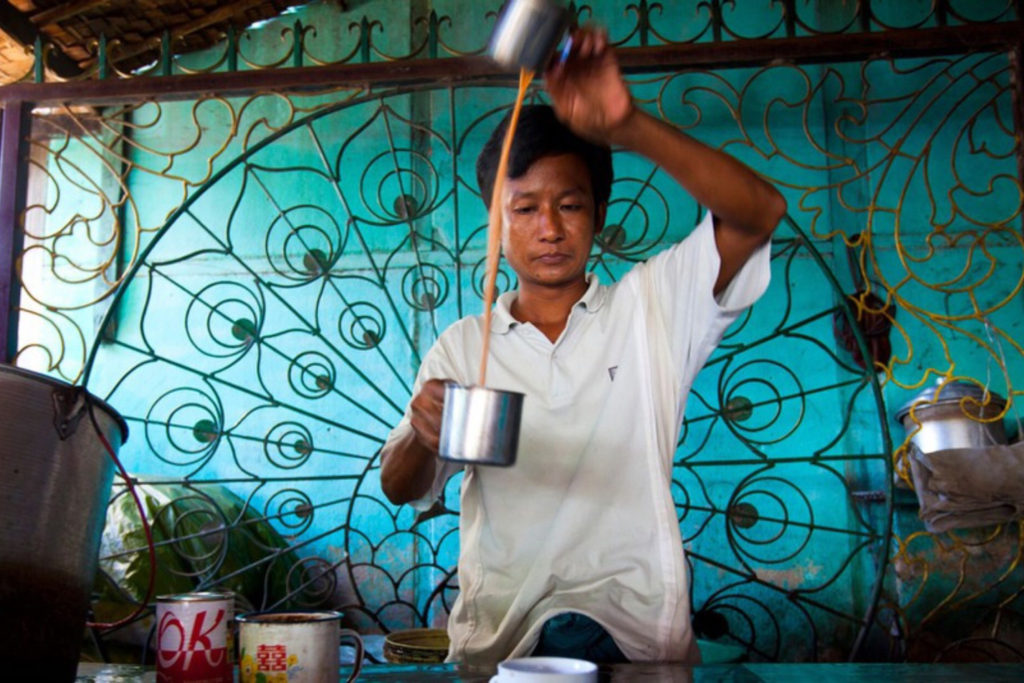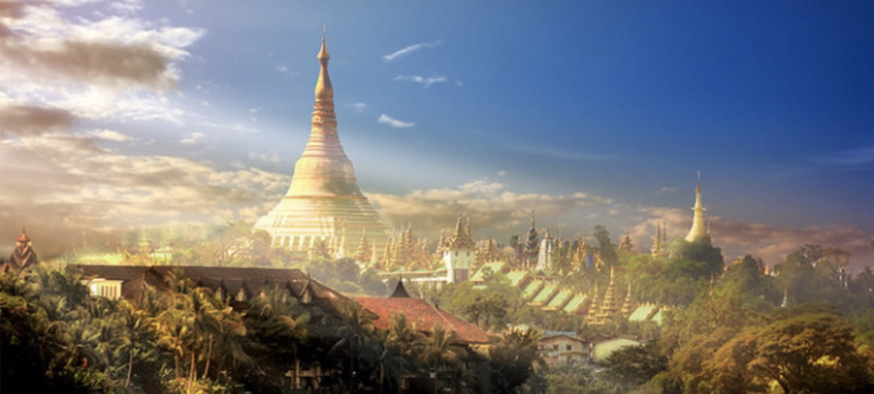Looking for fun things in Yangon, Myanmar ? the best places for foods and a visit . Whether you travel with group or friends or travel alone . It has something for every visitors. Being a local as well as experienced tour operator in Yangon , Myanmar , let me give you the top travel tips for getting around Yangon as below ;
First thing you need to know is that Myanmar used to be called Burma and Yangon formerly known as Rangoon? Yangon is the largest and busiest city in Myanmar which attracts a lot of locals from various part of the country for employment reasons. . It is exciting to explore this ancient city as it hasn’t been long they have opened their door to foreigners.
Their currency is called Kyat and local Burmese language is spoken everywhere, hardly anyone spoke English except the hotel and museum staffs. If you want to try a little, Mingalabar means Saying Hello , Saying Kyay Zuu Tin Par Dae is to Thank and Tata is to say Bye bye!
Getting around–
The best way to get around in Yangon is on foot. If that’s too far, then you can take a taxi from A to B. We’d say that about every second car in Yangon is a taxi, so you shouldn’t have any problems finding one.
Taxis don’t have meters, so you have to agree on a price beforehand. Overall, taxis are very cheap though. A simple trip through the city, e.g. from the Sule Pagoda to the Shwedagon Pagoda, will cost you 2,000 to 3,000 kyat. Expect to pay around 7,000 kyat for trips to the airport and the Aung Mingalar Bus Station.
Traffic in Yangon can get a bit congested, so you should make sure to plan enough time.
Besides the taxis, you can also catch a public bus. But it’s hard for travelers to tell where the buses are headed. The next stop is always announced, but understanding the announcement is the difficult part.
There are no scooters on the road in Yangon. Apparently, a general who felt threatened by some moped drivers a few years back, and so he ordered them off the streets from then on.
Accommodation – Variety of choice from Luxury hotel, boutique hotels to hostels. Check the price and book them here, or here.
if planning and booking your trip is a hassle, let me help! Contact me now.
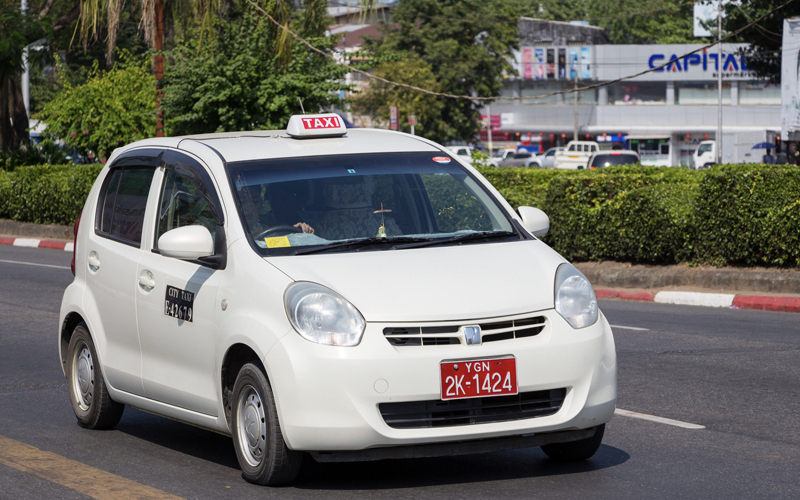
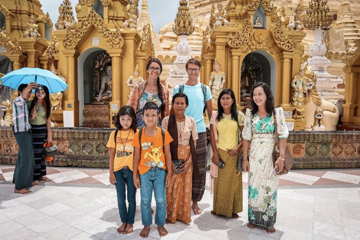
Interesting places around the city of Yangon
Downtown Yangon
Yangon’s commercial center, Downtown Yangon, is geographically the southern section of the city. Built around the Sule Pagoda and the Yangon River, Downtown Yangon is home to some of the city’s most impressive colonial buildings and historical sites.
Major attractions in Downtown Yangon include the Sule Pagoda, Bogyoke Aung San Market, Maha Bandula Park and the Myanmar Independence Monument. The Strand Hotel, Yangon’s most historically significant hotel, is located on Strand Road in Downtown Yangon.Northern Yangon
Many of Yangon’s most popular tourist attractions, parks and historical sites are located in the area immediately north of Downtown. Northern Yangon is where you’ll find the world famous Shwedagon Pagoda, Kandawgyi Lake and other attractions.
Further north is Inya Lake, Yangon’s largest lake and an exclusive neighbourhood home to the city’s elite.Inya Lake
The largest lake in Yangon, Inya Lake is located in the north of the city. Created as Yangon’s water reservoir during the country’s period as a British colony, Inya Lake is today one of the city’s most exclusive neighbourhoods and a popular recreation spot for locals.
Kandawgyi Lake
Located in northern Yangon, Kandawgyi Lake is a major landmark and a popular recreation area for city residents. Like Inya Lake, Kandawgyi Lake is an artificial lake created during the country’s period as part of the British Empire as a source of fresh water.
Karaweik, a 1970s reconstruction of an ancient Burmese royal barge, is built on the eastern shore of the lake.Yangon Central Railway Station
Destroyed during World War II and later rebuilt in a traditional Burmese style, Yangon Central Railway Station is a major landmark in Downtown Yangon. The station serves as the hub of Myanmar’s extensive but rather slow railway system.
Shwedagon Pagoda
Yangon’s most well known landmark, the Shwedagon Pagoda is a 99 metre historical stupa in Northern Yangon. As the country’s most important Buddhist site, the pagoda attracts locals in addition to a large number of tourists eager to see one of Buddhism’s most sacred stupas.
Open from 6:30 am until 10:00 pm, entrance to the Shwedagon Pagoda is $8 USD or 8,000 kyat. Footwear is prohibited inside the grounds — most visitors leave their shoes close to the entrance while they view the pagoda.
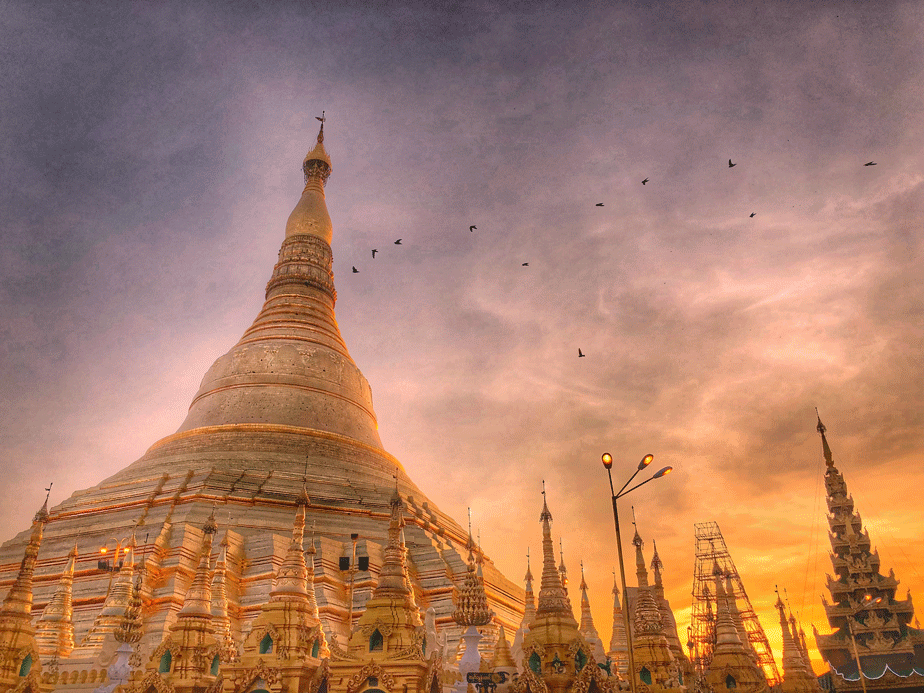
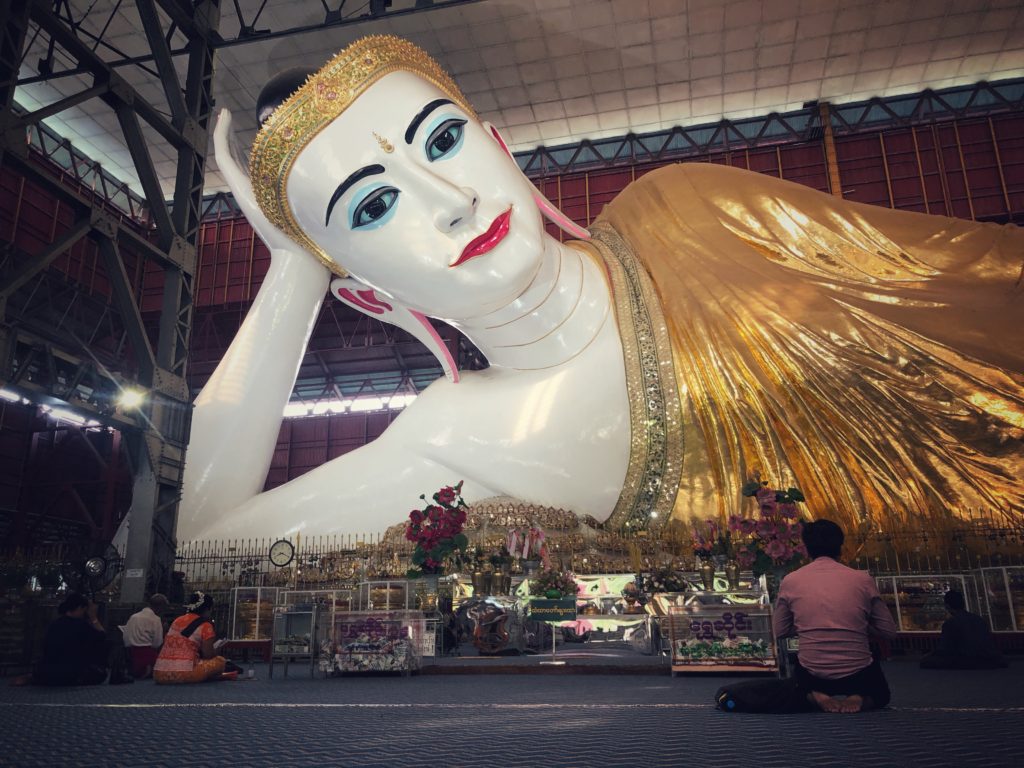
Walking around on foot
Please be noted that walking around Yangon on foot is not the best thing to do – but it is one of the good way to explore the city of Yangon in depth . t. I believe you can mix the famous things to do in any city, and also just walking around, experiencing the city, the life, the culture, the things that happen along the streets and taking it all in. When you walk around on foot and see what’s happening around you, you will feel the vibe and discover many things. Just start walking around and who knows what you will find!
The first “sight” of Yangon was the mix of old and modern high rise buildings. Some of the buildings were so ancient, run-down architecture which was probably beautiful in its hay days but looked grim in the present time but the high rise buildings, gave a feeling of the modern developing city.
The business of all kinds, from a colorful sidewalk fruits shop, teenagers running a meat shop, locals chewing their favourite betel nut, to a store selling fashionable items, locals reading palms and more! Downtown Yangon is a busy place – rain or shine! It may look a little bit messy but somehow, the city and the local make it work.
Shwedagon Pagoda
Shwedagon Pagoda is one of the important religious sights in Yangon, Myanmar! It is visited daily by the devotees.
Entrance on the day of 20th July 2018 was 10,000 Kyat = $8 USD. Ladies must cover the shoulders and legs and men no shorts. No-one is allowed to wear shoes or flip-flops in the Pagoda. It would be wise to bring a bag to carry around your footwear.
While walking, you will notice there were 7 days of the week nameplate around the base of the pagoda. according to belief and customary ,depending on the day you were born, you can go to that corner and worship your galaxy (the pillar at the back), your guardian angel (the yellow one), your spirit (the white one) and there was one more little statue below that (yourself)for good health and all the things you want!
Perhaps you can find spot some gold, jewels, and thousands of diamonds on the top of the pagoda, within that little golden umbrella looking thing?
Undoubtedly is a must visit when you are in Yangon, Myanmar.
It opens from 4 AM till 10 PM every day but closed on certain holidays, check the website for details
Chinatown Yangon – 19th Street
Chinatown in Yangon is the area of 24th through 18th street, west of the Sule Pagoda in downtown Yangon. It is usually jam-packed with foreigners and locals favorite as it also offers the nightlife in Yangon.19th Street is known as the barbecue street. Almost every door is a restaurant with glass cabinets full of veggie and non-veggie things skewered ready to be chosen and barbecued up. So, you just pick arestaurant, grab a table, choose the skewers you want, and relax as your food is cooked.20th street is known for Chinese food like rice congee and grilled pork skewers.
National Races Village
If you want to explore more than just visiting every temples and pagoda in Yangon. Consider going to National races village for some greenery, history, peace and quiet.
You can take the taxi to get there , it will cost around 3,000 or 4,000 Kyat ( Local Currency ) from the downtown area .
It is a large park with regions devoted to diverse cultural groups in Myanmar.
With that in mind, If you don’t have time to travel all over Myanmar to learn about the different tribes and their culture, this is a good option. Besides, it’s a nice place to spend some time – rain or shine/ solo or yolo!
It opens daily from 7 am to 5:30 PM and the entrance fee was 3000 Kyat per person (July 2018)
The Strand
If you are getting little bored after the umpteenth Pagoda or the continuous rain in monsoon season. The Strand can be your vibe!
This beautiful 5-star hotel is located in the heart of the city. A colonial beauty, this property was recently redone and it is spectacular. You do have to make reservations for dinner at The Strand Restaurant, as it is one of the only fine dining restaurants in Yangon, but it is well worth it. The bar was beautiful with delicious cocktails, pool table and mellow music on the background.
The decor quirky but gorgeous with the touch of pink on the walls and roses on the table. Staffs were thoughtful and super nice.
It is fun to mix your travels with luxury, street foods, nature, adventure, and sometimes fine wine and dine. After walking around, visiting beautiful temples and pagodas, trying local food and going even a step further from Yangon to National Races Village. You deserve a seat with a nice drink in a nice bar in Yangon. (Non- alcoholic beverage available) Treat yourself – you won’t be disappointed. Check and book your room with us at very reasonable prices.
If you have extra time, visiting the local food market, Bogyoke Aung San market, and Sule Pagoda is recommended as well.
Places to eat in Yangon
The best breakfast in Yangon
RANGOON TEA HOUSE
Tuck into mohinga, a hearty fish-and-noodle soup that is a Burmese breakfast staple. Here, the traditional catfish and rich, thick broth comes with sweet daggertooth fillets, fresh garbanzo beans, lemongrass and banana stems. Go big and order extra toppings of gourd, onion fritters and boiled duck eggs. The result: a tasty bowl of exotic goodness.
Address: Rangoon Tea House, 77–79 Pansodan Street, Yangon, Myanmar
Website: facebook.com/rangoonteahouse
The best afternoon tea in Yangon
THE STRAND CAFE
Papered in chartreuse-and-crimson toile wallpaper, the tea room of The Strand hotel is a must-visit. The Burmese version of afternoon tea has shrimp wontons, fermented-tea-leaf salad and delicate coconut sweets served in a gorgeous lacquered tiffin tin.
Address: The Strand Café, 92 Strand Road, Yangon, Myanmar
Website: hotelthestrand.com
The smartest spot for dinner in Yangon
GEKKO
In spite of its location inside the grand, century-old Sofaer Building, there is a relaxed vibe to this bistro. Grab a seat on the mezzanine for a bird’s-eye view of the dapper bartenders mixing herb-infused cocktails. Then order the shisito peppers dusted with coarse salt and lime, and traditional sashimi and sushi rolls topped with racy Burmese spices.
Address: Gekko, 535 Merchant Street, Yangon, Myanmar
Website: gekkoyangon.com
The best vegetarian spot in Yangon
PARIBAWGA CAFE
The new spot inside this furniture workshop acts as a showroom for Paribawga’s modernist tables and chairs. The walls are peeling with bright-turquoise paint, and the menu is vegetarian. Feast on grilled courgette dressed in tahini and Thai basil on a bed of ricotta; finish with a kachin-honey-and-ginger crème brûlée.
Address: Paribawga Café, 104 Bogalay Zay Street, Yangon, Myanmar
Website: paribawga.com
The best bar in Yangon
THE TODDY BAR
The Burmese imbibed toddy, the slightly sour and fermented sap
of the toddy palm, long before it was conscripted by the English. At this cosy and atmospheric speakeasy, cocktails are inspired by the national tipple: Coco-Colada – a coconut rum, absinthe and tropical-fruit concoction – arrives with clouds of coconut fog and packs a punch.
Address: The Toddy Bar, 77-79 Pansodan Street, Yangon, Myanmar
Website: facebook.com/thetoddybar
Other recommended restaurants in Yangon
- The Strand Grill
Excellent food, beautiful surroundings and fantastic service, albeit at prices that aren’t cheap even by Western standards, make The Strand Grill a good upmarket dining option in Yangon. - L’Opera Italian Restaurant & Bar
L’Opera Italian Restaurant serves high quality Italian cuisine beside Inya Lake. The outdoor dining area is a great place to enjoy Yangon’s warm and sunny weather. - Mandalay Restaurant at the Governor’s Residence
Located inside The Governor’s Residence, Mandalay serves tasty Southeast Asian food in a beautiful setting. A great choice for romantic dinners. - L’Alchimiste
L’Alchimiste serves excellent French food inside, and outside, a stunning colonial house on the banks of Inya Lake. - Anaimo
Popular with Japanese expats in Yangon, Anaimo serves high quality Japanese food made using fresh ingredients. - Taing Yin Thar
Taing Yin Thar serves excellent Burmese regional specialties cooked to a high standard in a rustic, relaxing environment. - Mai Thai
Located close to the Shwedagon Pagoda and opposite the Yangon Zoological Gardens, Mai Thai serves a selection of well known Thai dishes. - Yangon Bakehouse
One of several great cafés and bakeries in Yangon, Yangon Bakehouse offers tasty baked goods, healthy salads and fresh coffee. - 999 Shan Noodle Shop
Located right in the centre of Downtown Yangon, 999 Shan Noodle House serves cheap and tasty noodles just a couple of minutes from the Sule Pagoda. - Feel Myanmar Food
Conveniently located close to People’s Park and the Shwedagon Pagoda, Feel Myanmar Food serves a selection of traditional Burmese dishes.
How to get to Yangon
By Air
Yangon International Airport is one of three international airports in Myanmar. Yangon Airport handles flights from Southeast Asian regional centres such as Bangkok, Singapore, Saigon, Hanoi and Kuala Lumpur.
Flights to Yangon are also available from smaller Southeast Asian cities such as Chiang Mai and several major cities in India. Longer distance flights also depart from major East Asian cities such as Seoul and Tokyo.
Yangon International Airport also handles domestic flights to and from most destinations in Myanmar, such as Mandalay, Bagan, Pathein and Thandwe.
Check Skyscanner to compare airlines for the best prices and flight times to Yangon.By Train
Yangon is the hub of Myanmar’s extensive but slow railway system. Trains connect Yangon with other cities and destinations such as Mandalay and Bagan. Although it’s possible to get around Myanmar by train, travel times are very slow and rides can be extremely bumpy.
By Bus
Yangon is connected with most other destinations in Myanmar by bus. Due to the country’s partially completed new highway network, journeys can range from fast and relatively easy to slow and uncomfortable.
Destinations such as Mandalay, Bagan and the Ayeyarwady Region can be reached within six to ten hours from Yangon. The majority of buses to and from Yangon use the Aung Mingalar Bus Station, which is located close to Yangon International Airport.
What to eat
Instead of starting with a list of places, I thought it might be more helpful to start with a list of dishes you should look for in Myanmar, especially because many are difficult to replicate back home.
–Salad: In Myanmar—like Thailand, Laos, and other Southeast Asian countries—”salad” can mean almost anything that is eaten not quite hot but not quite cold. A few favorites: banana blossom salad in which cooked banana blossoms are mixed with toasted chickpea flour and a mix of sauces and seasonings, hand-mixed noodle salad in which noodles, rice, potatoes, and anything else are tossed with lime, tamarind juice, crunchy bits from crushed peanuts to fried yellow split peas, samosa salad, in which samosas are sliced and mixed with lime and cabbage, tamarind leaf salad where fresh tamarind leaves are mixed with ground peanuts and lime juice, and laphet thoke, the famous tea leaf salad in which shredded cabbage is seasoned with a paste of fermented tea leaves and bits of garlic a host of other seasonings. (If you only eat one salad in Myanmar, make sure it’s laphet thoke.)
–Mohinga: a noodle soup with a rich broth made with catfish, this is the country’s national dish and the most popular breakfast food we came across. It’s also now eaten throughout the day. It’s to Myanmar what pho is to Vietnam, even though it’s rarely seen outside of the country.
–Shan noodles: A lot of restaurants will have signs in English saying they serve Shan noodles, which can be wet or dry noodles. What separates them from other noodle dishes is they come from the Shan State, which borders China. The noodles often carry five spice seasonings and are accompanied by fermented mustard greens.
–Mangos during mango season (in the spring), especially, according to my friend Sarah, Sein Ta Lone—diamond mangos. There’s a saying in Myanmar that loosely translates to this: if it’s leaf, it’s tea, if it’s meat, it’s pork, and if it’s fruit, it’s mango.
-Myanmar tea: Made with evaporated and condensed milk, this milky black tea (think a cross between chai and Hong Kong milk tea) keeps the country running. Find a busy tea house, like Shwe Pyi Moe Teahouse in Mandalay, and try it. If you like it very sweet, ask for more condensed milk. If you like it not sweet at all, ask to leave it out. But the first time, just try what they give you and see what you think.
–Yogurt: Yogurt may be one of the many contributions that India made to Burmese food culture.

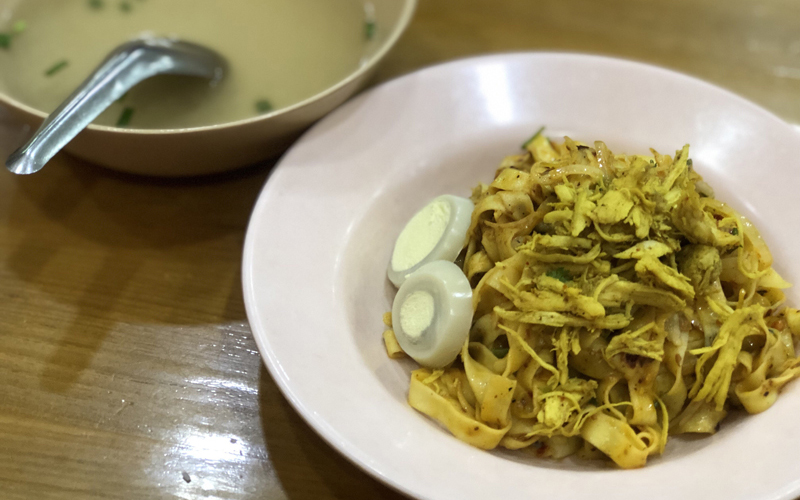
Street Food, Yangon and here are a few places to look for street food:
-Bogyoke Aung San Market caters to foreigners looking for souvenirs, but in front of the market are women selling several kinds of South Asian sweets.
-19th Street between Mahabandoola and Anawrahta roads is the main night market. You can sit wherever you’d like, order from different vendors, and somehow they find you. The best bets are the food grilled on skewers—fish, meat and offal, and vegetables are the most common. After we ate there one night, we bought a durian from a roadside stall and the vendor cut it up for us on the street, handing toothpicks to eat it out of the shell. It was like encountering a strong Southeast Asian version of a stinky cheese course to finish the meal.
Drinking in Myanmar
There are a few things about Myanmar that make it less of a place for drinking alcohol and more of a place for drinking tea. The country is deeply religious and conservative, for one, and people go to bed early. Plus, government cronies control the alcohol trade. All this is to say that despite a history that includes the Pegu Club, cocktail culture here seems to have died off with British Colonial rule. To be fair, it was the British who were drinking those cocktails, not anyone else.
What you will find here is Myanmar beer, a light beer reminiscent of Singha. But you’ll also find amazing nonalcoholic options, from fruit juices, coconut-and-tapioca “heart coolers,” and all that Myanmar tea. And everywhere you eat, you’ll encounter mild green tea, offered free at the table.
